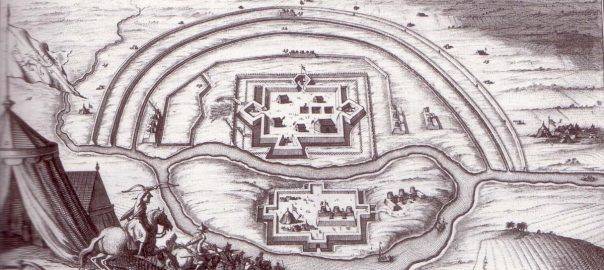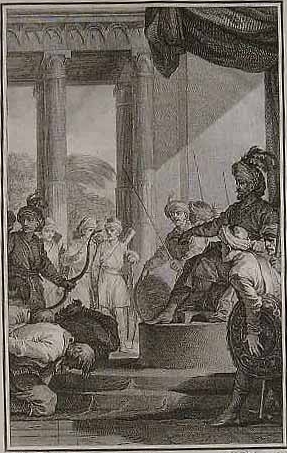1686 CE was the year in which a confrontation against the Mughal Empire sought by the relatively new head of English East India Company (EIC), Josiah Child, was launched in earnest, with the arrival in India of a fleet of 12 well-armed English Navy ships determined to impose the EIC’s conditions on the Mughals. (It did not turn out well.)

In 1686, also, the Ottomans, continuing their retreat from Eastern Europe, lost Buda to a Russian-Habsburg-Polish-etc Christian alliance. But things went less well for Russia in East Asia where a year-long struggle against the Qing for the fortified town of Albazin on the Amur River ended in the Russians agreeing to surrender Albazin to the Qing and to abandon the Amur River area in return for trading privileges in Beijing.
(The banner image above is a contemporary Dutch engraving of the Qing attack on Albazin.)
But meantime, over in that other powerful Asian land-based empire, the Mughal Empire…
Josiah Child gets his war on
William Dalrymple and others writing on EIC policy in this era are all clear that relatively new President of the EIC, Josiah Child, gravely misunderstood and under-estimated the power of the Mughal Empire. In 1682, Child had sent a guy called William Hedges to be the EIC’s regional manager for Bengal, and Hedges had asked the Mughal Governor of the region, Shaista Khan to grant the EIC broad trading privileges throughout the Mughal Empire. (Remember Shaista Khan? He was Emperor Aurangzeb’s uncle.) This page on Wikipedia describes the whole English/EIC confrontation with the Mughals that ensued, and reminds us that the Mughal Empire was “proto-industrialized… the world’s largest economy of the time.”
John Clark Marshman’s 1867 History of India (vol. I, Ch.8) takes up the tale of this conflict (pp.210-13):
A rival East India Company had been formed in London under high auspices, and great efforts were made to obtain a charter for it; but the old Company was still patronized by the Court, and was endowed with the additional powers of admiralty jurisdiction, which authorized them to seize and confiscate the property of their rivals abroad. They now solicited the permission of the viceroy [Shaista Khan] to erect a fort at the mouth of the Hooghly, or on its banks, that they might more effectually intercept the vessels of interlopers. The representative of the Mogul had a horror of European fortifications, and, if he took any interest in the question of rival companies, must naturally have desired that the number of investments on which he could levy contributions, should be increased. The request was therefore refused, and not without reason, for such a fortification would have given the Company the absolute control of the port and of the commerce of the province. But the viceroy went further, and imposed a duty of 3½ per cent. on their goods, notwithstanding the exemption acquired by the imperial firman.
Such demands had been often made before, and as often eluded by a liberal donative; but the East India Company had become inflated with an idea of their own power and importance, and determined to extort redress by going to war with the Mogul empire. They applied to James II. for permission to retaliate the injuries of which they complained, and fitted out the largest armament which had ever been dispatched from England to the East. Admiral Nicholson was sent out with twelve ships of war, carrying 200 pieces of cannon and a body of 600 men, to be reinforced by 400 from Madras. His instructions were to seize and fortify Chittagong, for which purpose 200 additional guns were placed on board, to demand the cession of the surrounding territory, to conciliate the zemindars, to establish a mint, and to enter into a treaty with the raja of Arracan – in short, to found a kingdom. But these ambitious projects were destined to a severe disappointment. The fleet was dispersed during the voyage, and several of the vessels, instead of steering for Chittagong, entered the Hooghly, and being joined by the Madras troops, anchored off the Company’s factory. The arrival of so formidable an expedition alarmed the viceroy, and he offered to compromise his differences with the English; but an unforeseen event brought the negotiation to an abrupt close. Three English soldiers, strolling through the marketplace of Hooghly, quarrelled with some of the government policemen, and were severely beaten. Both parties were reinforced, and a regular engagement ensued, in which the natives were completely discomfited. At the same time the admiral opened fire on the town and burnt down 500 houses, as well as property belonging to the Company to the extent of thirty lacs [= 3 million] of rupees.
The Mogul commandant hastened to solicit a suspension of arms, and assisted in conveying the remainder of the saltpetre on board the ships. Job Charnock, the English chief, considering Hooghly no longer safe, retired on the 20th December, 1686, to the little hamlet of Chuttanutty, about twenty-six miles down the river, on the site of which subsequently arose the magnificent capital of British India. There the viceroy renewed and spun out the negotiations till his troops could be assembled, when he marched down to attack the English encampment, and Job Charnock retired with his soldiers and establishments to the island of Ingelee, at the mouth of the river. It was a low and deadly swamp, covered with long grass, and destitute of any fresh water. It appears incredible that a man of Charnock’s experience, who had been thirty years in India, and who must have known the nature of that jungle, should have selected the most unhealthy spot in Bengal for an entrenched camp. The Mogul general allowed him to remain there without molestation, well knowing that disease would spare his soldiers the use of their swords. In three months one half of the troops were dead, and the other half fit only for hospital.
At this juncture, when the prospects of the English were reduced to the lowest ebb, the viceroy made unexpected overtures to Charnock. It appears that simultaneously with the dispatch of Admiral Nicholson’s expedition from England [that is, late 1685?], the Court of Directors instructed Sir John [Josiah] Child to withdraw their establishments from Surat and the neighbouring ports, and to commence hostilities on the western coast. An English fleet was therefore employed in blockading the Mogul harbours, and the pilgrim ships were captured. The bigoted Aurungzebe hastened to seek a reconciliation with those who commanded the highway to Mecca, and orders were issued to the governors of provinces to make terms with them. Charnock returned to Chuttanutty, and the pacification was on the mint of being completed when the appearance of Captain Heath rekindled the flame. The Court of Directors, on hearing of the failure of Admiral Nicholson’s expedition, instead of folding up their ambitious project, determined to prosecute it with increased vigour, and sent out reinforcements under Captain Heath. Immediately on his arrival he disallowed the treaty then pending, and having embarked on board the ships under his command, lying off Chuttanutty, the whole of the company’s officers, civil and military, proceeded to Balasore, which he bombarded and burnt. He then sailed to Chittagong; but finding the fortifications stronger than be had anticipated, crossed the bay, and landed the whole of the company’s establishments at Madras; and not a vestige was left of the commercial fabric which had been reared in Bengal by fifty years of painful exertion.
This confrontation took four years to bring to a close, so I’m going to jump ahead to 1690 and use the summation of the whole affair provided on p.24 of Dalrymple’s great 2019 book, The Anarchy: The East India Company, Corporate Violence,and the Pillage of an Empire:

So to go back to 1686. That was 54 years after Portugal’s always well-armed trading empire had tried to impose its conditions on the Mughals in Bengal and been royally (and humiliatingly) slapped down by the Mughals, and Josiah Child thought he could mount an even greater challenge to Mughal sovereignty of the region and get away with it…
But he could not.
Aurangzeb’s “fly-swatting” put-down of the EIC in 1686 was also notable because it would prove to be the last time the Mughals were strong enough to defend their own terrain and sovereignty from the Europeans in such a way. But I get ahead of myself.

